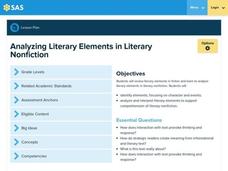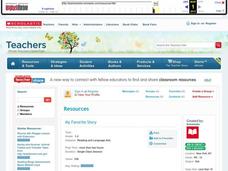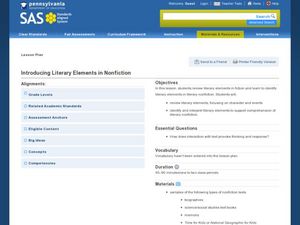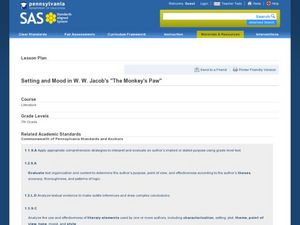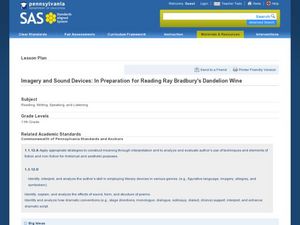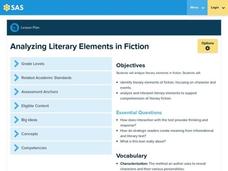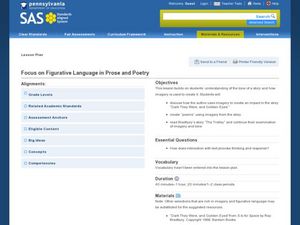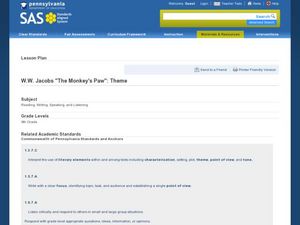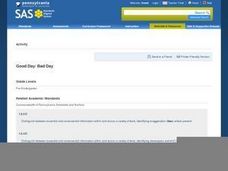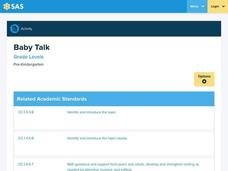Curated OER
I, Robot: Chapter One
Learners discuss literature about technology in the 20th century. For this book study lesson, students read I, Robot by Isaac Asimov and compare the fiction to technology in the 20th century.
Film English
iDiots
Mobile phones have become an integral part of many people's lives. Examine the role and impact of technology through a short video and related activities. Pupils share what they use their phones for before viewing the film. Class...
Pennsylvania Department of Education
Analyzing Literary Elements in Literary Nonfiction
Fourth graders identify the literary elements of a nonfiction text. In this literary elements lesson plan, 4th graders read the text Piano Starts Here--The Young Art Tatum and fill in a chart that includes the events from the book....
Curated OER
My Favorite Story
Students discuss their favorite book. In this book discussion lesson, students name the title and tell what makes the book special. Students also review the setting, plot, conflict, and resolution. Students make a book that tells all of...
Curated OER
Plot and Conflict in W.W. Jacob's "The Monkey's Paw"
Tenth graders analyze the use of literary elements in W.W. Jacob's "The Monkey's Paw." Literary analysis is accomplished by a review of the plot and order of events in the story. Learners work in pairs to match the events from the story...
Curated OER
Introducing Literacy Elements in Nonfiction
Explore nonfiction writing with your class. They will identify elements in nonfiction by reviewing elements of fiction. Then they use biographies, memoirs, menus, Time for Kids, and text books to identify elements of nonfiction. They...
Curated OER
Focus on Figurative Language
Using the poems "First Snow" by Ted Kooser and "Eating Alone" by Yi-Young Lee (or other suggested poems by Robert Frost or Sara Teasdale), middle schoolers search for examples of figurative language. Guide your learners by discussing...
NASA
Let's Investigate Mars
Take your science class on a hypothetical field trip to Mars with an engaging astronomy lesson. After first learning about NASA's Mars rover missions, young scientists plan their own scientific investigations of Earth's...
Peter Bunzl
Cogheart and Moonlocket
Peter Bunzi takes readers to the Victorian era with two stories, Coghaert and Moonlocket. Accompany the literary time warp with a companion packet that offers a plethora of exercises. Learning...
Curated OER
The Importance Setting and Mood in Fiction
Seventh graders examine the setting in pieces of fiction. In this story analysis lesson, 7th graders investigate the setting in fictional stories and the importance it has. Students discover new vocabulary terms applying to...
Curated OER
No Regrets: a Poetry Analysis
Students read a poem and use the TPCASTT strategy for analysis. In this poetry analysis lesson, students journal about their future goals and read John Updike's "Ex-Basketball Player." Students discuss the purpose of the poem and...
Curated OER
Imagery and Sound Devices: In Preparation for Reading Ray Bradbury's Dandelion Wine
Twelfth graders analyze Ray Bradbury's use of techniques and elements of fiction as well as nonfiction in the novel Dandelion Wine. In this novel analysis lesson plan, 12th graders analyze the sensory techniques in Dandelion Wine....
Pennsylvania Department of Education
Analyzing Literary Elements in Fiction
Students analyze the characters and events in fictional writing. In this literary elements lesson, students study the meaning of the words characterization and fiction. They listen to the story Pigsty by Mark Teague, or any other book...
Curated OER
Main Events in Fiction
Young scholars complete a literature analysis of fiction texts to study elements of fiction. In this fiction analysis instructional activity, students read various fiction texts and examine them to learn about fiction elements. Young...
Curated OER
Focus on Figurative Language in Prose and Poetry
Students place emphasis on the use of figurative language when analyzing prose and poetry. In this figurative language lesson, students explore the tone of a story and its imagery. Students read and discuss how the author uses imagery in...
Curated OER
Crafting Poetry: A Sensory Journey
Tenth graders experiment with poetry devices to write poems. In this poetry lesson, 10th graders participate in learning stations. Students create a word pool and select a word from the list to create a line of poetry. Students complete...
Curated OER
W.W. Jacob's "The Monkey's Paw" Theme
Pupils identify the theme of "The Monkey's Paw" and relate it to prior knowledge. In this "The Monkey's Paw" lesson, students discuss fate and coincidence and debate which one controls destiny. A test is chosen as the winner...
Pennsylvania Department of Education
The Talking Feather
Students use the feather when they want to talk and the rest of the class listens. In this listening lesson plan, students practice good manners by respecting the student with the feather.
Curated OER
Brown Bear
Students read the book Brown Bear, Brown Bear, What Do You See? and respond to the questions asked by the teacher. In this comprehension lesson plan, students respond to the animals in the book.
Curated OER
Down By The Bay
Students read the book Down By The Bay and sing the song that goes with it. In this Down By The Bay lesson plan, students also come up with other rhymes that could go with the song.
Curated OER
What's My Tone?
Students answer a question in the same tone of voice that you ask it in. In this tone lesson plan, students respond to the volume and expression of the teacher's voice.
Curated OER
Good Day/Bad Day
Students read the book Alexander and the Terrible, Horrible, No Good, Very Bad Day and discuss a bad day that they have had. In this bad day lesson plan, students compare their bad day with the story.
Curated OER
Pre-k Book Talk
Students read the book Corduroy and tell if they liked or didn't like the story. In this books lesson plan, students have a stuffed bear to hold while reading the story.
Curated OER
Baby Talk
Young scholars read the story Toilet Tales and discuss the importance of using grown up words and not baby talk words. For this speaking lesson plan, students discuss how they are now in school and use appropriate language.


